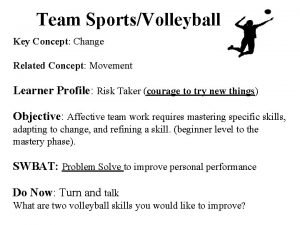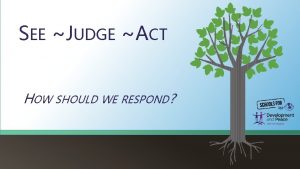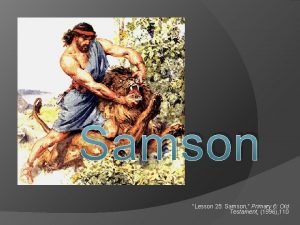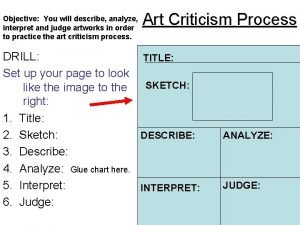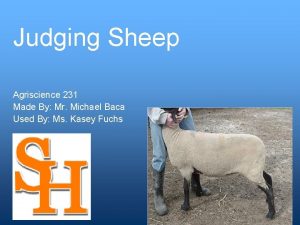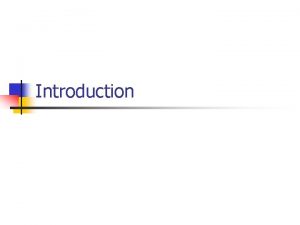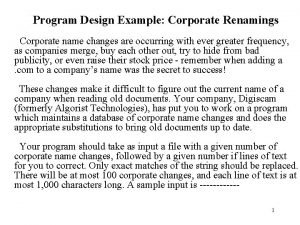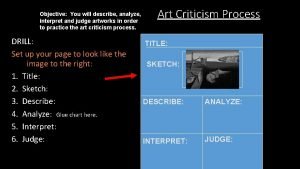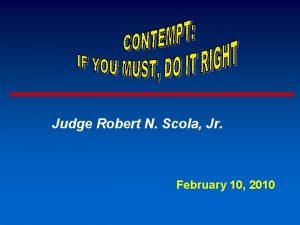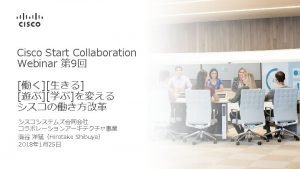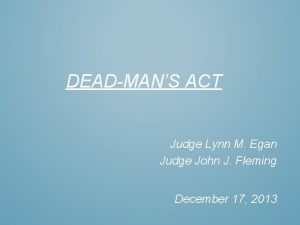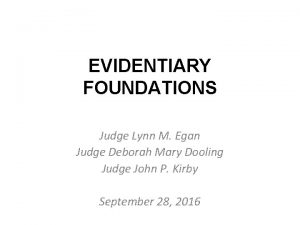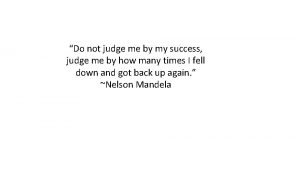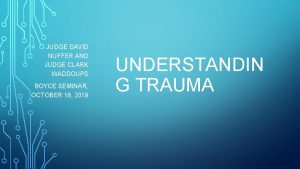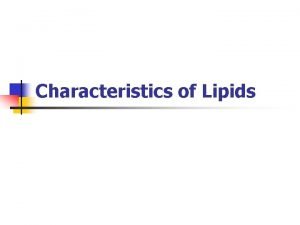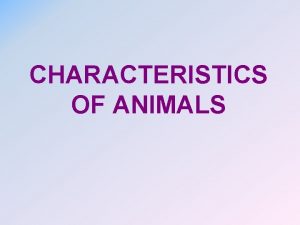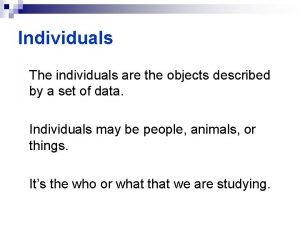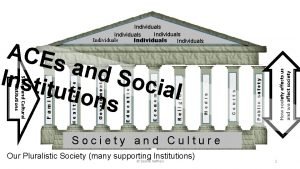SOFTWARE CHARACTERISTICS Different individuals judge software on different


































- Slides: 34

SOFTWARE CHARACTERISTICS • Different individuals judge software on different basis. This is because they are involved with the software in different ways. For example, users want the software to perform according to their requirements. Similarly, developers involved in designing, coding, and maintenance of the software evaluate the software by looking at its internal characteristics, before delivering it to the user. Software characteristics are classified into six major components.

Software Characteristics • Functionality – Refers to the degree of performance of the software against its intended purpose. • Reliability – Refers to the ability of the software to provide desired functionality under the given conditions. • Usability – Refers to the extent to which the software can be used with ease.

Software Characteristics • Efficiency – Refers to the ability of the software to use system resources in the most effective and efficient manner. • Maintainability – Refers to the ease with which the modifications can be made in a software system to extend its functionality, improve its performance, or correct errors.

Software Characteristics • Portability – Refers to the ease with which software developers can transfer software from one platform to another, without (or with minimum) changes. In simple terms, it refers to the ability of software to function properly on different hardware and software platforms without making any changes in it.

Software Characteristics • Portability – In addition to the above mentioned characteristics, robustness and integrity are also important. Robustness refers to the degree to which the software can keep on functioning in spite of being provided with invalid data while integrity refers to the degree to which unauthorized access to the software or data can be prevented.

Software Characteristics • Portability – In addition to the above mentioned characteristics, robustness and integrity are also important. Robustness refers to the degree to which the software can keep on functioning in spite of being provided with invalid data while integrity refers to the degree to which unauthorized access to the software or data can be prevented.

Classification of Software • Software can be applied in countless fields such as business, education, social sector, and other fields. It is designed to suit some specific goals such as data processing, information sharing, communication, and so on. It is classified according to the range of potential of applications. These classifications are listed below.

Classification of Software • System software: This class of software manages and controls the internal operations of a computer system. It is a group of programs, which is responsible for using computer resources efficiently and effectively. For example, an operating system is a system software, which controls the hardware, manages memory and multitasking functions, and acts as an interface between application programs and the computer.

Classification of Software • Real-time software: This class of software observes, analyzes, and controls real world events as they occur. Generally, a real-time system guarantees a response to an external event within a specified period of time. An example of real-time software is the software used for weather forecasting that collects and processes parameters like temperature and humidity from the external environment to forecast the weather. Most of the defence organizations all over the world use real-time software to control their military hardware.

Classification of Software • Business software: This class of software is widely used in areas where management and control of financial activities is of utmost importance. The fundamental component of a business system comprises payroll, inventory, and accounting software that permit the user to access relevant data from the database. These activities are usually performed with the help of specialized business software that facilitates efficient framework in business operations and in management decisions.

Classification of Software • Engineering and scientific software: This class of software has emerged as a powerful tool in the research and development of next generation technology. Applications such as the study of under-surface activities, and programming of an orbital path for space shuttles are heavily dependent on engineering and scientific software. This software is designed to perform precise calculations on complex numerical data that are obtained during real time environment.

Classification of Software • Artificial intelligence (AI) software: This class of software is used where the problem-solving technique is non-algorithmic in nature. The solutions of such problems are generally non-agreeable to computation or straightforward analysis. Instead, these problems require specific problem-solving strategies that include expert system, pattern recognition, and game-playing techniques. In addition, they involve different kinds of search techniques which include the use of heuristics. The role of artificial intelligence software is to add certain degrees of intelligence to the mechanical hardware in order to get the desired work done in an agile manner.

Classification of Software • Web-based software: This class of software acts as an interface between the user and the Internet. Data on the Internet is in the form of text, audio, or video format, linked with hyperlinks. Web browser is a software that retrieves web pages from the Internet. The software incorporates executable instructions written in special scripting languages such as CGI or ASP. Apart from providing navigation on the Web, this software also supports additional features that are useful while surfing the Internet.

Classification of Software • Personal computer (PC) software: This class of software is used for both official and personal use. The personal computer software market has grown over in the last two decades from normal text editor to word processor and from simple paintbrush to advanced image-editing software. This software is used predominantly in almost every field, whether it is database management system, financial accounting package, or multimedia-based software. It has emerged as a versatile tool for routine applications.

Changing Nature of Software • The software world is rapidly moving towards accepting open source and away from treating it as a foster child. • There are reasons why Open Source is slowly taking over and there is a lot we can learn from it.

Changing Nature of Software • Why Open Source: – Open Source allows anyone to add in features they think are needed – there is a decision by the owner but the owner doesn’t drive everything. It is inherently by its nature always in front of the customer (you and me). – Open Source uses the Internet as its own, flexible, very infinite and very personalized office space. This office space is also responsible of Open Source being so productive.

Changing Nature of Software • Why Open Source is successful: – In general it is widely accepted fact that if you love your job you will do your best and the results will be great. That is what Open Source is all about. People who want to join the community, join and help. There is no monetary rewards but people work and contribute because they like and love to.

Changing Nature of Software • Why Open Source is successful: – Open Source employs the whole population of Software Developers to work on the projects they like. And thus by its nature it has the best of the talent and the most motivated people working on it. The results are amazing.

Changing Nature of Software • Agile: – Agile methodology is the NEW way of software development. It is different from the traditional waterfall method in that it asks to take your product to the customers ASAP in a Minimal Viable Product (MVP). It also suggests that the people (Software Developers) know what is good for the software and they can choose what they need to work on. It also says that everyone can provide feedbacks to the backlog – the list of things that needs to be built.

Software Engineering A Layered Technology

A quality Process • Any engineering approach must rest on an quality • The "Bed Rock" that supports software Engineering is Quality Focus

Process • Foundation for SE is the Process Layer • SE process is the GLUE that holds all the technology layers together and enables the timely development of computer software. • It forms the base for management control of software project.

Methods • SE methods provide the "Technical Questions" for building Software • Methods contain a broad array of tasks that include communication requirement analysis, design modelling, program construction testing and support

Tools • SE tools provide automated or semiautomated support for the "Process" and the "Methods“ • Tools are integrated so that information created by one tool can be used by another

SOFTWARE PROCESS MODELS • To solve actual problems in an industry setting, a software engineer or a team of engineers must incorporate a development strategy that encompasses the process, methods and tools layers. – Linear Sequential Model – Prototype Model – RAD model – Incremental Model – Spiral Model

SOFTWARE PROCESS FRAMEWORK • The process of framework defines a small set of activities that are applicable to all types of projects • The software process framework is a collection of task sets • Task sets consist of a collection of small work tasks, project milestones, work productivity and software quality assurance points

SOFTWARE PROCESS FRAMEWORK Umbrella activities • Software project tracking and control – In this activity, the developing team accesses project plan and compares it with the predefined schedule. – If these project plans do not match with the predefined schedule, then the required actions are taken to maintain the schedule.

SOFTWARE PROCESS FRAMEWORK Umbrella activities • Risk management – Risk is an event that may or may not occur. – If the event occurs, then it causes some unwanted outcome. Hence, proper risk management is required.

SOFTWARE PROCESS FRAMEWORK Umbrella activities • Software Quality Assurance (SQA) – SQA is the planned and systematic pattern of activities which are required to give a guarantee of software quality. For example, during the software development meetings are conducted at every stage of development to find out the defects and suggest improvements to produce good quality software.

SOFTWARE PROCESS FRAMEWORK Umbrella activities • Formal Technical Reviews (FTR) – FTR is a meeting conducted by the technical staff. – The motive of the meeting is to detect quality problems and suggest improvements. – The technical person focuses on the quality of the software from the customer point of view.

SOFTWARE PROCESS FRAMEWORK Umbrella activities • Measurement – Measurement consists of the effort required to measure the software. – The software cannot be measured directly. It is measured by direct and indirect measures. – Direct measures like cost, lines of code, size of software etc. – Indirect measures such as quality of software which is measured by some other factor. Hence, it is an indirect measure of software.

SOFTWARE PROCESS FRAMEWORK Umbrella activities • Software Configuration Management (SCM) – It manages the effect of change throughout the software process.

SOFTWARE PROCESS FRAMEWORK Umbrella activities • Reusability management – It defines the criteria for reuse the product. – The quality of software is good when the components of the software developed for certain application and are useful for developing other applications.

SOFTWARE PROCESS FRAMEWORK Umbrella activities • Work product preparation and production – It consists of the activities that are needed to create the documents, forms, lists, logs and user manuals for developing a software.
 Software judge
Software judge Judge hancock prescott az
Judge hancock prescott az Volleyball flag signals
Volleyball flag signals For adult
For adult John proctor the crucible character traits
John proctor the crucible character traits What secret does john openly admit to danforth
What secret does john openly admit to danforth Reverend hale the crucible
Reverend hale the crucible The crucible act 3 discussion questions
The crucible act 3 discussion questions Volleyball signals
Volleyball signals See, judge, act worksheet
See, judge, act worksheet Lds story of samson
Lds story of samson Analyze
Analyze Judgement impossible hand signal in volleyball
Judgement impossible hand signal in volleyball Juror
Juror Judging sheep
Judging sheep Jury vs judge
Jury vs judge John 7 14
John 7 14 Judge donnelly cook county
Judge donnelly cook county What animal would judge us the most
What animal would judge us the most Uva problem set
Uva problem set Here come da judge
Here come da judge See judge act methodology
See judge act methodology The crucible john proctor quotes
The crucible john proctor quotes Cant judge a powder
Cant judge a powder Volleyball line judge signals
Volleyball line judge signals Immfa
Immfa Davies v waldron
Davies v waldron John baulch
John baulch Judge.softuni
Judge.softuni Corporate name example
Corporate name example Can you judge art objectively
Can you judge art objectively Judge robert scola
Judge robert scola Judge moore poem
Judge moore poem Hkoi.judge
Hkoi.judge Sli.do softuni
Sli.do softuni








